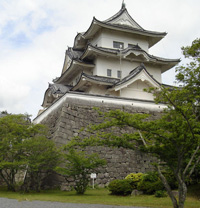“Ninjutsu is not something that should be used for personal desires.
It is something that should be used when no other choice is available,
for the sake of ones country,
for the sake of one’s lord,
or to escape personal danger.
If one deliberately uses it for the sake of personal desires,
the techniques will indeed fail totally.”
Momochi Sandayu – Soke Iga Ryu Karate, Koto Ryu Koppojutsu, Hakuun Ryu Ninpo / Gyokko Ryu Kosshijutsu
This quote from Momochi Sandayu a famous Shinobi master who existed in the 1500s in Iga Province – Japan.

The famous Shinobi Momochi Sandayu, the head of the Momochi Clan of Shinobi, existed in the beginning of the golden age of Ninjutsu when the Shogunate style of government came about with the rise of the Samurai caste. Momochi Sandayu was born in 1525 and is known to be one of the founders of Iga ryu Ninjutsu and trained many of the most famous Shinobi of that time including Hattori Hanzo and Ishikawa Goemon. Momochi Sandayu was known by his title of nobility Tanba no Kami. He used many different disguises and aliases and his history is covered my a shroud of deception. One of his aliases is the name Fujibayashi Nagato who was the master of Koga Ryu Shinobi. Momochi was the head of many households but his main home was at Ryuguchi in Nabari City in Iga Province. Momochi was also rumoured to have had a Shinobi training facility in Hojiro in Ueno City. Sandayu managed to maintain three seperate households with a seperate wife and family living in each. By establishing himself in three different locations with three different identities he ensured his own safety and secrecy.
Momochi Sandayu was the Soke (Grandmaster/Family head) of the Koto Ryu Koppojutsu, he learnt Gyokko Ryu Kosshijutsu from Hakuunsai and he studied the Togakure Ryu Ninjutsu and passed its knowledge to the Natori family of Kishu which later became a part of Kishu Ryu Ninjutsu. His strategy in combat was to use unorthodox techniques in order to make his adversary believe he did not know what he was doing. The decree of Momochi Sandayu follows:
“The art of the Shinobi is not to be employed for personal gain”
“The art of the Shinobi is to be employed, with a deep understanding of the essence of Gyokko, for country, for lord, or in times of inescapable personal danger”
“If the art of the Shinobi is willfully employed for personal gain, the art of our forefathers will certainly be defeated”
Iga Province is a small mountain ringed basin, known as Ueno basin, in the centre of Japan’s Kansai region, on the island of Honshu. During the early Muromachi Period of Japan’s history, which covered the approximate period of 1336 – 1573, Iga Province became independent from their feudal leaders and established a form of republic. The Iga Republic was known as Iga Sokoku Ikki (伊賀惣国一揆) in Japanese.
Iga Province was said to be controlled by three ninja clans with Fujibayushi in the north, Hattori in the center, and Momochi in the south. It was in his camp at Hojiro that Momochi trained his famous Iga Shinobi and controlled the southern end of the province.
Momochi challenged the power of the Christian warlord Oda Nobunaga as he ascended to power. Momochi was using his Shinobi network to secretly steer the fate of Japanese history in order to shape its future. The Iga Shinobi allied themselves to their Buddhist brethren and worked to protect the sacred shrines and temples of Buddhism. Oda Nobunaga and his two generals, Hideyoshi Toyotomi and Ieyasu Tokugawa were known to use spies but none were from Iga and Koga. Oda Nobunaga and Hideyoshi Toyotomi were overtly opposed to Buddhism and burnt temples at every opportunity but this made them the sworn enemies of the Shinobi of both Iga and Koga.
Oda Nobunaga learnt of the success of the Iga Shinobi operations against his forces but by being so successful the Iga Shinobi had revealed themselves. There were also failed assassination attempts against Oda Nobunaga which made him determined to defeat the Iga Shinobi on their own turf. He sent his son with into Iga on a mission to destroy every last Shinobi but due to the mountainous terrain and humidity the Shinobi headquarters was virtually inaccessible and Oda Nobua suffered a humiliating defeat against the Iga Shinobi. In 1581 Oda Nobunaga led an army 46,000 warriors to attack a force of less than 4,000 Iga Shinobi in order to annihilate the Shinobi forever. The sheer size of the army was too much for Momochi Sandayu’s Iga Shinobi to repel and the Iga Ryu Shinobi were defeated. Oda Nobunaga slayed large numbers of Shinobi and executed any survivors but many Shinobi fled the region and scattered themselves all over Japan with some allying themselves to Tokugawa Ieyasu. Momochi Sandayu was recorded to have fought with great courage but disappeared.
After the invasion of Iga, Momochi Sandayu travelled east to Kii Province where he disguised himself as a farmer until he heard the news of Nobunaga’s murder, by one of his own generals, on June 10th 1582. Momochi Sandayu returned to Iga and attempted to unite the Momochi and Hattori clans together but this attempt failed and much infighting between the two clans ensued. Eventually the clan leaders Momochi Sandayu and Hattori Hanzo dueled and Momochi Sandayu died by his student’s hands.
 It is becoming quite apparent that we are living in one of those special times in history when the very fabric of what we call society, government and perception is changing.
It is becoming quite apparent that we are living in one of those special times in history when the very fabric of what we call society, government and perception is changing.




